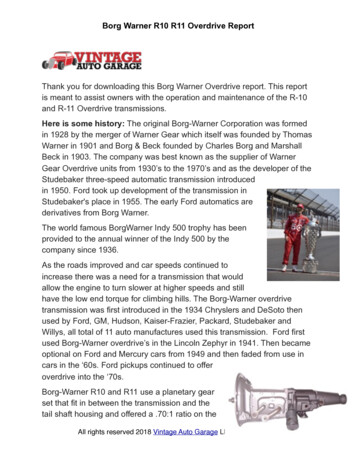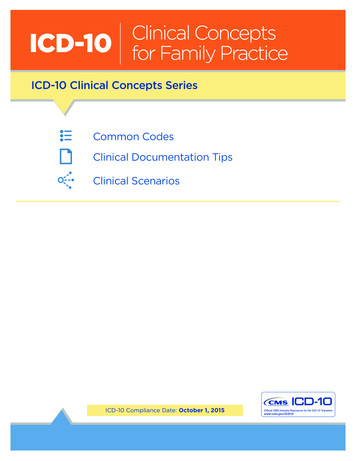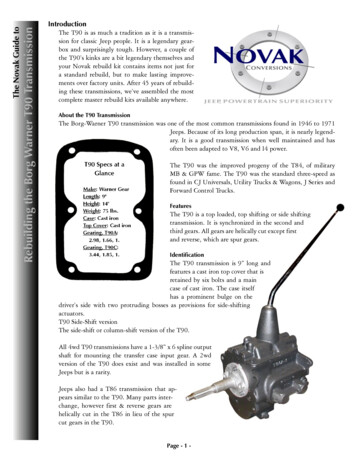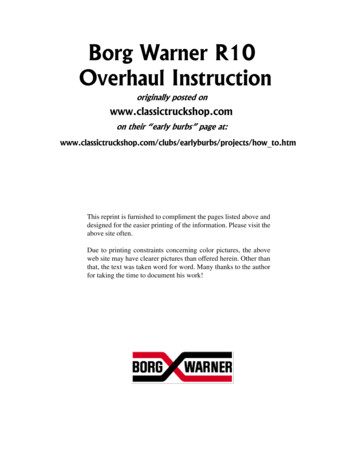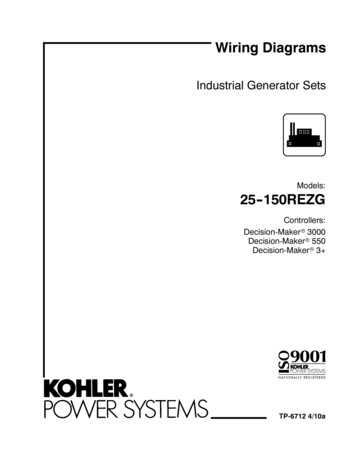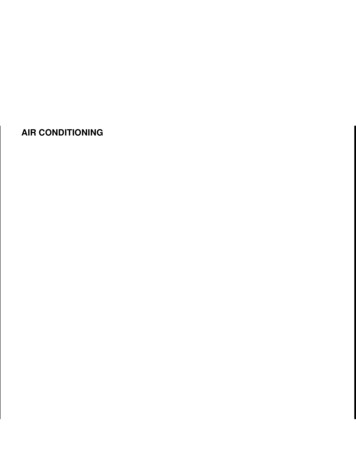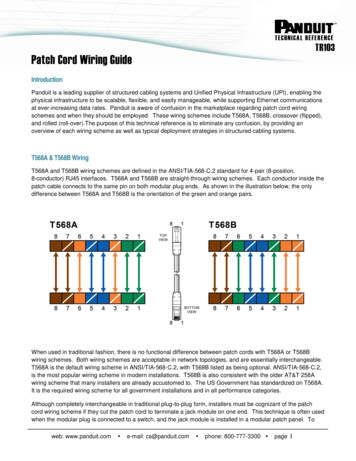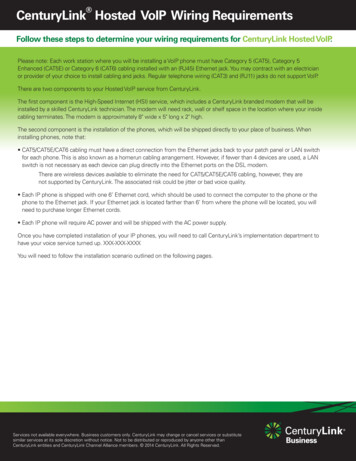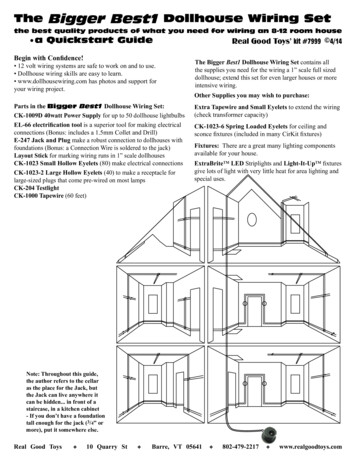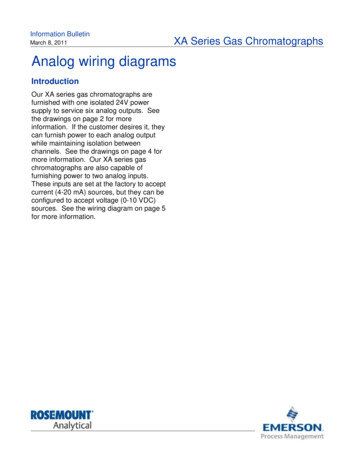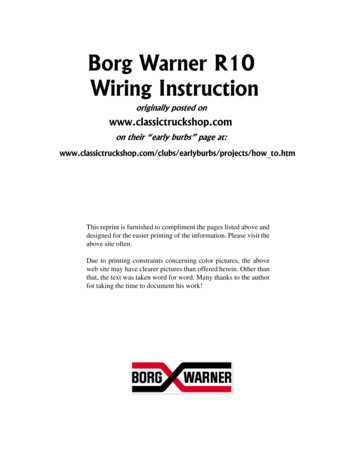
Transcription
Borg Warner R10Wiring Instructionoriginally posted onwww.classictruckshop.comon their “early burbs” page cts/how to.htmThis reprint is furnished to compliment the pages listed above anddesigned for the easier printing of the information. Please visit theabove site often.Due to printing constraints concerning color pictures, the aboveweb site may have clearer pictures than offered herein. Other thanthat, the text was taken word for word. Many thanks to the authorfor taking the time to document his work!
Borg Warner Overdrive WiringIf you are lucky enough to land your mitts on a T-85N tranny, this page is for you! These wereused in Studebakers, GM, and Ford cars and trucks. It gives your truck a semi-automatic trannysetup, and you will have a 3/4 split shift unit. The diagram below is for those of you who get atranny without all the relays etc. that are in the vehicle. If you already have one, you may consider rewiring it for split shifting.This tranny setup can be operated in several ways.In town, I take off in 2nd, then let it shift itself into 2nd over. I can redline at over 70 in 2nd over,so it’s more than enough gearing for in town. (with a 3:96 rear end) I never touch the gear shiftdoing it this way, and use the clutch only when I have to stop completely.On the road, I use the clutch and shift normally through the three gears, then let it glide up intooverdrive. It’s like a 4 speed then. When towing, I split-shift thru all six from a dead stop.I can also use the high range lock switch to run a high set of gears as a normal three speed, butwith about a 2:56 rear end instead of it’s normal 3:96. 1st will take me to about 35 MPH, then2nd will do almost freeway speed, then 3rd runs 1900 RPM at 70 MPH.It’s hard to get used to with it’s freewheel clutch. When I first installed it, I would forget todeclutch at a stop sign. After it was almost stopped, it would chug and stall. (oops) You can takeoff, then shift without using the clutch at all. It also gets rid of the first gear grind when coming toa stop, because the tranny’s output shaft is unloaded from the driveshaft.If you need to be towed, put the T-handle IN for freewheel. The tranny’s output shaft won’t eventurn while it’s towed. The only thing that will spin is the ring gear/clutch assembly in the overdrive unit.Some cautions:Some things you HAVE to remember: The tranny has a one-way freewheeling clutch. When parking, put it inREVERSE and/or set the brake!! If you leave it in any other gear, the truck will roll away on you!! The only timeit won’t do this, is when the freewheel clutch is locked out. Also, lockout the freewheel clutch when going downmountain passes!! The truck will idle as it rolls downhill and will have NO engine braking whatsoever unless theoverdrive is engaged. If you downshift the O/D while going downhill, you will lose all engine braking, andyou will gain speed getting it shifted back into O/D!! I usually lock it out on gravel roads so I can have enginebraking also. This is what the T-handle on the dash is for. IN is for overdrive, and/or freewheel operation, andOUT is normal transmission operatio
This is a diagram for wiring a split shift controlsetup for your T-85N transmission. This can beused for one you’ve bought outright and have nooriginal circuits for, or modifying the one youalready have. The DPDT relay is a Double PoleDouble Throw relay. Radio Shack carries them.The passing gear lockout switch is for when youwant to run flat out without it dropping out oftop gear.Operation:For a full six gear split shift: take off in 1st like normal, push the Upshift button. (This is theonly time you need the upshift button, the governor does it after 27MPH) Let up on the gas, thenstep on it again. It’s now in 1st over. Shift to 2nd while holding the release switch. Now you’re in2nd, let go of the release switch then let the gas pedal up and step down again. Now you’re in2nd over. Hold the release switch and shift to 3rd. Let the release switch up, and do the gas pedaltrick again, and you will be in top gear.For passing, there’s two ways. Use the release switch then let up and reapply the gas pedal, orstomp it down far enough to operate the microswitch on the throttle linkage. The microswitchacts like an automatic transmission during 2nd gear kickdown.Notes: The electric shift solenoid will stay in and/or out of gear until the engine torque is almostnil. The solenoid puts spring pressure on a set of locking dogs, so it just waits for a let up intorque. You can work the shift switches, but it won’t do anything until the gas pedal is let up thenreapplied. If you shift the tranny using the clutch, coastdown torque will make it hold positiontoo. Kind of like an override over the electric controls.This is the split-shift control box in my ‘Burb.The left button is SHIFT-UP, the middle is RELEASE, and the rightis HIGH-RANGE. The engaged indicator is on the dashboard. Iadded rubber grommets to isolate it from the gearshift shaft to eliminate transmission noise from the cab.
This is a Borg Warner T-85N case with thecomponants removed. The hole on the left is for thefreewheel clutch lockout. The right hole is for thespeedometer. These photos are of my spare overdrive unit.Here’s a view of the planetary gear set and sungear, and the ring gear is in the case. The centersection is removed. This case mounts to one side ofthe center section, and the tranny to the other. Thestepped down part behind the ring gear is for thefreewheel clutch roller bearings. The T-85N is avery stout unit!!The overdrive solenoid with the coverremoved. When powered, the shaft putspressure on locking dogs until engine torqueis released, then the locking dogs engage theplanet set case, and the ring gear then rotates27% faster than the input shaft. The largeterminal is the (S)olenoid line, and the(I)gnition terminal has a short to groundwhen the shaft is in the engaged position.This is to cause the engine to shut off long enough for the solenoid to release during passing geardownshifts. The solenoid actually has two coils. Oneis a “slam-in” coil and it is disconnected after theshaft moves in, then a low current “holding coil”keeps it in place.This is the passing gear microswitch on my old carburetor. I didn’t use the circuit with the built up 400small block. It puts out way too much torque for thetranny gears to survive the slamming of very manypassing gear kickdowns. I use the release switch andease it down a gear instead.
This centrifical switch (Borg Warner calls it a governor) is a key part of the O/D setup. It switches to ground at27 MPH, and releases at 21 MPH. They put thought into thespeeds at which it operates. If you are in 2nd, it will shift upat 27 MPH. You let up on the gas, then step on it again for2nd over. When you turn a corner, it will automatically downshift back to 2nd as you make the turn. It’s GREAT!!This is the cable for the freewheel clutch lockout. Ididn’t quite catch the lever it attaches to in thephoto, but it’s on the right just out of view. Run aT-handle cable to somewhere on the dashboard.You will use this to lock out the one way clutch.The solenoid is mounted in the center section. Thetranny is a standard 3 speed except for two extraholes. One is for the reverse-O/D lockout rod, andthe other is an oil flow hole.This is Borg Warner’s original wiring diagram scanned from a 1965 Chilton’s manual. If youhave an all original truck with the overdrive, this diagram should be usable. The DPDT relay inmy circuit substitutes for the special kickdown switch that mounts above the gas pedal in the oldvehicles.
This is the cable for the freewheel clutch lockout. I didn't quite catch the lever it attaches to in the photo, but it's on the right just out of view. Run a T-handle cable to somewhere on the dashboard. You will use this to lock out the one way clutch. The solenoid is mounted in the center section. The tranny is a standard 3 speed except .
